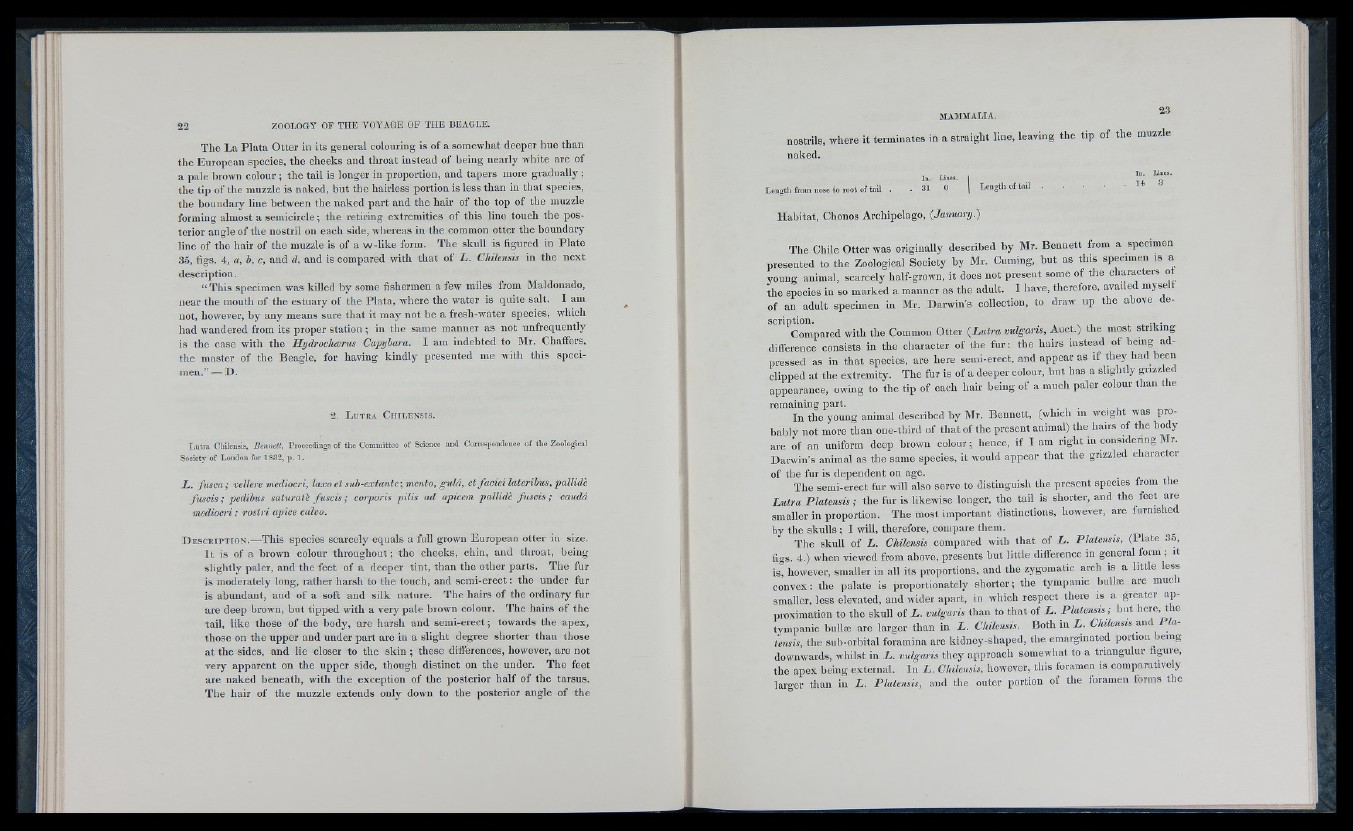
The La Plata Otter in its general colouring is of a somewhat deeper hue than
the European species, the cheeks and throat instead of being nearly white are of
a pale brown colour ; the tail is longer in proportion, and tapers more gradually ;
the tip of the muzzle is naked, but the hairless portion is less than in that species,
the boundary line between the naked part and the hair of the top of the muzzle
forming almost a semicircle; the retiring extremities of this line touch the posterior
angle of the nostril on each side, whereas in the common otter the boundary
line of the hair of the muzzle is of a w -like form. The skull is figured in Plate
35, figs. 4, a, b, c, and d, and is compared with that of L . Chilensis in the next
description.
“ This specimen was killed by some fishermen a few miles from Maldonado,
near the mouth of the estuary of the Plata, where the water is quite salt. I am
not, however, by any means sure that it may not be a fresh-water species, which
had wandered from its proper station; in the same manner as not unfrequently
is the case with the Hydroclusrus Capybara. I am indebted to Mr. Chaffers,
the master of the Beagle, for having kindly presented me with this specimen.”—
D.
2 . L u t r a C h i l e n s is .
L utra Chilensis, Bennett, Proceedmgs of the Committee of Science and Correspondence of the Zoological
Society of London for 1832, p. 1.
i . fusca; vellere mediocri, laxo etsuh-extante\mento, gulâ, et faciei lateribus, pallid e
fuscis ; pedibus saturaü fuscis ; corporis pilis ad apicem pallidè fuscis ; caitda
mediocri; rostri apice calvo.
D e s c r i p t i o n .—This species scarcely equals a full grown European otter in size.
It is of a brown colour throughout ; the cheeks, chin, and throat, being
sliglitly paler, and the feet of a deeper tint, than the other parts. The finis
moderately long, rather harsh to the touch, and semi-erect : the under finis
abundant, and of a soft and silk nature. The hairs of the ordinary fur
are deep brown, but tipped with a very pale brown colour. The hairs of the
tail, like those of the body, are harsh and semi-erect ; towards the apex,
those on the upper and under part are in a slight degree shorter than those
at the sides, and lie closer to the skin ; these differences, however, are not
very apparent on the upper side, though distinct on the under. The feet
are naked beneath, with the exception of the posterior half of the tarsus.
The hair of the muzzle extends only down to the posterior angle of the
M AM M A LIA .
nostrils, where it terminates in a straight line, leaving the tip of the muzzle
naked.
Length from nose to root of tail
In. Lines
. 31 0 Length of tail
In. Lines
14 3
Habitat, Chonos Archipelago, (January.)
The Chile Otter was originally described by Mr, Bennett from a specimen
presented to the Zoological Society by Mr, Cuming, bnt as this specimen is a
young animal, scarcely half-grown, it does not present some of the characters ot
the species in so marked a manner as the adult. I have, therefore, availed myself
of an adult specimen in Mr. Darwin's collection, to draw np the above descripCtioomn.
p ared with the Common Otter (Lutra vulgaris, Auct.) the most striki.ng
difference consists in the character of the fur: the hairs instead of being adpressed
as in that species, are here semi-erect, and appear as if they had been
clipped at the extremity. The fur is of a deeper colour, but has a slightly grizzled
appearance, owing to the tip of each hair being of a mucb paler colour than the
remaIinni nthge p yaorut.ng animal described by Mr. Bennett, (which m weight was probably
not more than one-third of that of the present animal) the hairs of the body
are of an uniform deep brown colour; hence, if I am right in considering M i.
Darwin’s animal as the same species, it would appear that the grizzled character
of the fur is dependent on age.
The semi-erect fur will also serve to distinguish the present species irom tiie
Lutra Platensis; the fur is likewise longer, the tail is shorter, and the feet are
smaller in proportion. The most important distinctions, however, are furnished
by the skulls ; I will, therefore, compare them.
The skull of L. Chilensis compared with that of L . Platensis, (Plate 35,
figs. 4.) when viewed from above, presents but little difference in general form ; it
is, however, smaller in all its proportions, and the zygomatic arch is a little less
convex: the palate is proportionately shorter; the tympanic bullie are muc i
smaller, less elevated, and wider apart, in which respect there is a greater approximation
to the skull of i . vulgaris than to that of L . Platensis; but here, the
tympanic bullie are larger than in L . Chilensis. Both in L . Chilensis and i te-
tensis, the sub-orhital foramina are kidney-shaped, the emarginated portion being
downwards, whilst in X. vulgaris they approach somewhat to a triangulur figure,
the apex being external. In X. Chilensis, however, this foramen is comparatively
larger than in X. Platensis, and the outer portion of the foramen forms the